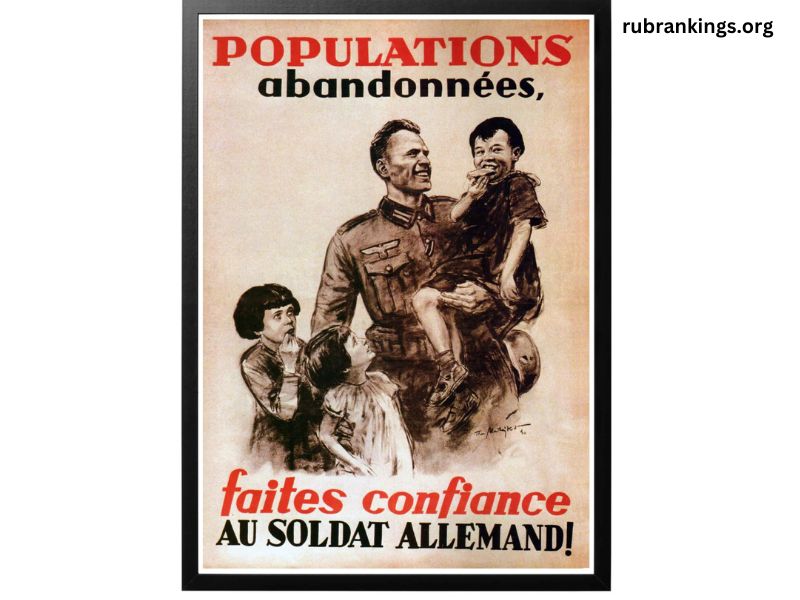World War I and World War II brought about profound changes in societies across the globe. One of the most significant aspects of these wars was the use of propaganda to influence public perception and morale. In Germany, propaganda posters played a crucial role in shaping the narrative around soldiers, civilians, and the concept of loyalty and trust. Among these, the “German Soldier” propaganda poster stands out as a poignant reminder of the complexities surrounding themes of abandonment, trust, and national identity during times of conflict.
The Context of German Propaganda
During both World Wars, Germany utilized a robust propaganda machine to bolster national pride, encourage enlistment, and maintain morale on the home front. The government, realizing the power of visual media, employed artists and graphic designers to create compelling imagery that would resonate with the public. Posters were used to depict soldiers not merely as warriors but as embodiments of national strength and virtue.
In the context of World War I, the German Empire faced a series of challenges. The war had begun with initial successes but soon devolved into a protracted conflict characterized by trench warfare and staggering casualties. In this environment, propaganda became essential in maintaining public support for the war effort and in justifying the sacrifices being made by soldiers.
The Visual Language of Propaganda
The “German Soldier” propaganda poster typically features a strong, stoic soldier, often in a heroic pose. These images were carefully designed to evoke feelings of admiration and trust in the armed forces. The soldier is usually depicted wearing a uniform that symbolizes strength and duty, reinforcing the idea that he is a protector of the nation and its values.
The use of color, imagery, and text in these posters was meticulously crafted. Dark, somber colors conveyed the gravity of war, while brighter hues might be employed to suggest hope and resilience. Bold typography accompanied images of soldiers to convey messages of courage and sacrifice, reinforcing the idea that the soldier is worthy of trust and admiration.
Themes of Abandonment and Trust
One of the critical themes that emerges from the “German Soldier” propaganda is the juxtaposition of trust and abandonment. The propaganda sought to instill a sense of loyalty among the populace towards the soldiers fighting on the front lines. At the same time, it also highlighted the perceived abandonment of these soldiers by civilians who were not directly experiencing the hardships of war.
The message was clear: to trust in the soldier was to trust in the nation’s future. Propaganda reinforced the idea that soldiers were sacrificing their lives for the greater good, and any lack of support from the home front was tantamount to betrayal. This narrative created a sense of duty among civilians to rally behind the troops, emphasizing the need for unity in times of crisis.
Psychological Impacts on the Populace
The psychological impact of such propaganda was profound. It fostered a sense of guilt among those who were not serving in the military, pushing many to contribute in various capacities—whether through enlistment, support of war bonds, or participation in volunteer efforts. The “German Soldier” poster, with its messages of trust and loyalty, served to galvanize the civilian population, making them feel complicit in the war effort.
Moreover, the portrayal of soldiers as noble and trustworthy figures served to distance the general populace from the grim realities of warfare. By focusing on the ideals of courage and sacrifice, the propaganda often glossed over the brutal consequences of battle, which included loss of life and psychological trauma. This disconnect created a duality where the soldier was both a hero and a figure of abandonment, caught in a war that many civilians only understood in abstract terms.
The Role of Women in Propaganda
Another critical aspect of the “German Soldier” propaganda was its appeal to women. As men were drafted into the military, women were encouraged to take on new roles in the workforce and in society. Propaganda posters often depicted women as caregivers and supporters of the soldiers, reinforcing traditional gender roles while simultaneously expanding their societal contributions.
Women were portrayed as the backbone of the home front, managing households and working in factories to support the war effort. The trust placed in women to uphold national morale and contribute to the war was vital, and propaganda emphasized their crucial role in supporting the soldiers. This dual narrative of trust and abandonment extended to women, as they were called to support the war while grappling with the potential loss of their loved ones.
Legacy and Reflection
The legacy of the “German Soldier” propaganda poster is multifaceted. On one hand, it served its intended purpose of rallying the population around the war effort and fostering a sense of national unity. On the other hand, it also left behind a complex psychological imprint on a generation that grappled with loss, trauma, and the aftermath of war.
In the years following World War I and II, the themes of trust and abandonment continued to resonate. The narratives surrounding soldiers changed, and public perceptions evolved. The heroism of the soldier became intertwined with a recognition of the sacrifices made by those on the home front, leading to a more nuanced understanding of the impact of war on society as a whole.
Contemporary Relevance
Today, the themes explored in the “German Soldier” propaganda poster remain relevant in discussions about war, loyalty, and national identity. The way societies commemorate and support veterans often reflects these historical narratives. Trust in soldiers and the military continues to be a complex issue, shaped by contemporary conflicts and the experiences of those who serve.
Moreover, as we examine the role of propaganda in shaping public perception, it becomes clear that the methods employed during the World Wars are not merely relics of the past. Modern propaganda—whether through social media, advertising, or political messaging—continues to influence how we view soldiers and the conflicts in which they participate.
Conclusion
The “German Soldier” propaganda poster is more than just a piece of wartime art; it is a lens through which we can explore the intricate relationships between trust, abandonment, and national identity during times of conflict. As we reflect on the impact of such propaganda, it is essential to recognize the enduring legacy it has left on society and the continued relevance of its themes in contemporary discussions about war and service. Understanding this history allows us to foster a more empathetic and informed dialogue about the complexities of loyalty, sacrifice, and the human cost of conflict.



